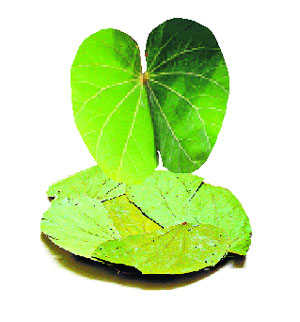Taur leaves can easily replace plastic, thermocol
Chiranjit Parmar
Use of plastic and plates, cups, etc, made of similar material for serving food is soon going to be banned in Himachal. An announcement to this effect was made by the Chief Minister on June 5 at a public function at Sunder Nagar. The decision has been taken to make the state free of non-biodegradable material.
Use of plastic ware by food vendors has greatly increased during the recent decades due to its “use and throw” nature. Use of moulded thermocol plates for serving food has started even in villages too. Now an alternative for this material would be required. One of the alternatives could be pattals and donas made from the leaves of the wild growing creeper taur. Fortunately, pattals are already in use for serving food on social occasions.
Taur plant
Taur (Bauhinia vahlii) is a large climber growing in hill forests between 600 to 1200 m. Taur vines are large, up to25 cm thick and grow up to35 metres. The leaves are two-lobed and 15 to 45-cm wide. One requires three to five leaves to make one pattal. It also bears large thick pods. The unripe pods are sometimes roasted in fire and the seeds are eaten.
New plants of taur can easily be raised from seed, which germinates easily.
Use of taur pattals in Himachal
Taur pattals have been in use in many parts of Himachal for ages. Till 50 years back, nearly every family in Mandi took their lunch consisting of rice and dal and on pattals only. The supply of pattals was assigned to a special community called dasali. Like a milkman and dhobi, each family had its family dasali too. Now, dasalis no more supply pattals and these are sold at shops.
The business of pattals
Pattal-making is a cottage industry in Himachal. Men bring leaves from the forest. One person can collect 700–800 leaves in a day. There is no royalty or tax on collecting taur leaves from the forest. Three-five leaves, depending upon size, are needed to make one pattal.
The leaves are stitched together with very thin pins made from bamboo. This is done by women. One woman can make around 200 pattals a day.
There is no cost involved in making pattals. There are traders who buy pattals from villagers and take these to town for sale. One of the traders, Teekam Ram, told me that around 10,000 pattals were sold in Mandi town every day. The price keeps fluctuating with demand, still the value of this business in Mandi town is not less than Rs 30 lakh. So, it could be worth several crores of rupees in whole of Himachal Pradesh.
Mechanisation of pattal-making
Rotary Club of Mandi has taken up a project on mechanising pattal-making in collaboration with a Women’s Self-Help Group. They have set up a small plant where the leaves are stitched together.









